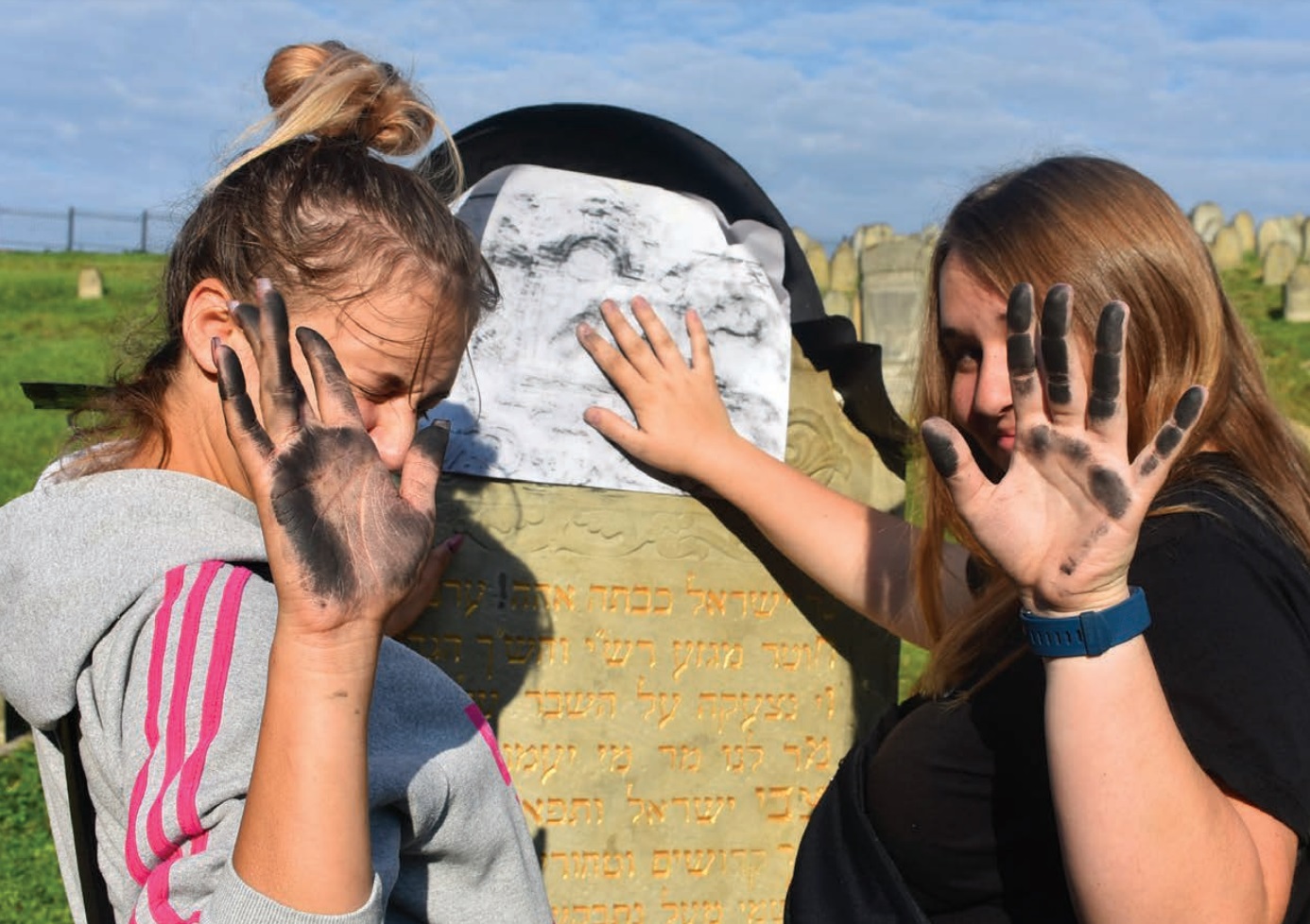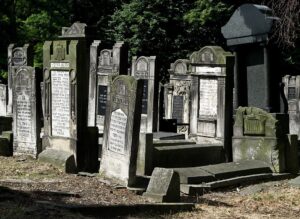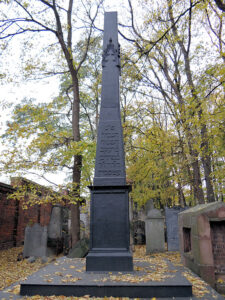The following article is an excerpt from the report “Jewish Cemeteries as an educational resource in high school education” written by Prof. Joanna Beata Michlic. The full report is available online at: https://www.jewishcemeteries.eu/publications/jewish-cemeteries-as-an-educational-resource-in-high-school-education

Cover of the report “Jewish Cemeteries as an educational resource in high school education”.
Jewish cemeteries offer educators an opportunity to introduce students to pre-war Jewish life and culture, as well as to the rupture created by the Holocaust in an engaging and experiential manner. The study of these sites could bring home the fact that the destruction of European Jewry is not a subject that is alien and remote to these students but, on the contrary, is part of their local community’s history and geography. Instead of encountering facts in textbooks, students can walk through hallowed Jewish spaces and come face-to-face with evidence of the diversity of Jewish life, examples of Jewish practices, stories of individual Jewish lives and the after-effects of genocide. By learning in Jewish cemeteries, students can not only gain intellectual knowledge, but also develop empathy towards those buried; the famous and the unknown, adults and children.
Thus, the integration of Jewish cemeteries into high school education can make studying pre1939 Jewish heritage and the Holocaust a meaningful intellectual and spiritual experience, relevant to young students’ lives. In cultures where there is respect for the dead (annual All Souls’ Day commemorated on 1 November by Catholics), incorporating Jewish cemeteries should be seen as part of a long-term innovative educational programme, shaped with the participation of nongovernmental organisations, grassroots activists, headmasters, teachers and students.
According to Antony Polonsky, Emeritus Professor of Holocaust Studies at Brandeis University and chief historian of the Museum of the History of Polish Jews in Warsaw, “Jewish cemeteries constitute an immense historical resource in formal and informal education about the Jewish past and present in the post-communist region. One of the first acts which accompanied the establishment of a Jewish community was the creation of a cemetery.” Jewish culture required the separation of the dead from places of human habitation but, at the same time, Jewish culture greatly honoured and respected the dead who were buried with ceremony in accordance with the regulations of Jewish law. Families who could afford it provided impressive tombstones (matzevot). Religious figures, whether rabbis or tsaddikim, were often buried in a separate enclosure called an ohel. This is a part of Jewish heritage through which high school students can encounter individual Jews, and gain understanding and respect for Jewish traditions.
The Jewish cemetery performed several other important functions. It was customary to visit the graves of one’s parents and other relatives on the Jewish New Year. In addition, people came to the cemetery to seek the intervention of the dead, whether relatives or holy individuals, in the case of illness or plague, or to bless a bride and groom before a wedding. Specific prayers, such as those found in Ma’aneh Lashon (The Response of the Tongue, Prague, 1615, with more than 20 editions before 1800) were recited, while women who visited the cemetery on the anniversary of a relative’s death or on the High Holidays, recited appropriate tkhines (prayers in Yiddish). These visits often had a ritual character, such as processions on the Ninth of Av commemorating the destruction of the first and second Temples, and those on the eve of Rosh Hashanah and Yom Kippur. In some places, on Yom Kippur eve, women enclosed the cemetery (or some of the graves) with a string while reciting prayers. Pieces of this were later used for candlewicks. Communal ceremonies with prayers to end plague were sometimes accompanied by the marriage of poor orphans, called shvartse khupes or shvartse khasenes (‘black weddings’). High school students are usually curious to learn about such traditions.

Jewish cemetery in Lodz (Poland). Author: Nikodem Nijaki
As acculturation and assimilation made its inroads in Jewish communities, those who favoured the reform of Jewish life began to make use of tombstones using vernacular language rather than Hebrew, and were sometimes buried in special sections of the cemetery. Jewish industrialists and bankers, like the Poznański family in Łódź, built imposing mausoleums for their families towards the end of the nineteenth and beginning of the twentieth century.
Before the Second World War, there were approximately 1,200 Jewish cemeteries in Poland and around 800 have been identified. Large numbers of Jewish cemeteries can also be found in other countries in Central and Eastern Europe, including Lithuania, the Czech Republic, Slovakia, Hungary, Romania, Moldova and Ukraine. Only a few have been restored and how the remainder can be properly preserved remains a serious problem. Most of the preservation projects were initiated in the 1990s and carried out by NGOs and enthusiastic activists with the assistance of religious and local governmental authorities, and school students. These efforts have been supported by the EU, international Jewish heritage NGOs such as ESJF, the Foundation for Jewish Heritage and Centropa, and individual Jewish descendants of East European Jews living in the West. But there are still many Jewish cemeteries in various states of disrepair. All cemeteries face the ravages of time and weather, and most were desecrated in the past. However, Jewish cemeteries continue to be vandalised in the present. This too is part of what educators can teach in these spaces since vandalisation of cemeteries illustrates that antisemitism still exists, even though Jewish communal life has been reduced to near extinction. Viewing, discussing and helping to remedy antisemitic graffiti, garbage and general disregard is a powerful experiential tool teaching young people empathy and respect for the dead as well as for living members of religious and ethnic minorities.
Many educators recognise the value and importance of the space of the Jewish cemetery as a rich educational resource and are enthusiastically supportive of developing new models incorporating Jewish cemeteries into the educational system. They agree that Jewish cemeteries are meaningful sites for engaging with various aspects of the pre-1939 Jewish past, the Holocaust, as well as contemporary issues of memory, commemoration and antisemitism.

Powazki Jewish Cemetery in Warsaw (Poland). Author: Jolanta Dyr.
According to Dr Robert Williams, Executive Director of USC Shoah Archives and Chief Advisor to IHRA, incorporating the space of the Jewish cemetery into education has the potential “to frame new thinking on how to build awareness around, teach, and preserve Jewish life and culture. Importantly, this is not limited to countries within the European Union, but also relates to other European countries with less developed infrastructure for the preservation of important cultural sites. This activity therefore has the potential to enhance cooperation between countries across continental Europe around sets of issues that relate to the preservation of Jewish life, thereby
opening the door to a more normative approach to this imperative challenge.” Williams also recognises that utilising the Jewish cemetery in education could enhance learning outcomes as they relate to cultural pluralism and inter-ethnic respect, and demonstrate that the legacy of Jewish life in Eastern Europe is intertwined with the history and culture of nonJewish Europeans.
Prof. Steven T. Katz, Slater Professor of Jewish Holocaust Studies at Boston University and Chairman of the Academic Committee of the Claims Conference, views using Jewish cemeteries in education as a poignant tool for drawing “attention to the immediacy of the subject by showing how Jewish communities existed throughout Europe, in both large and small cities and villages.” In his view, “the study of gravestones will show and humanise various aspects of Jewish life, i.e. presenting husbands, wives, parents, children, teachers, rabbis, workers etc. That is, it will familiarise students with the presence of local Jews and also de-mystify the subject. Jews and their identities will become more than myth and hearsay.”
Prof. Polonsky states that Jewish cemeteries are “a remarkable tool for conveying information about the nature of the Jewish communities in the towns where they are to be found. Thus, the large cemetery in Warsaw on Okopowa Street can be used, in conjunction with other Jewish sites in the city, to present a history of what was the largest Jewish community in Europe. The smaller cemetery in Bródno in Praga illustrates the problems the community faced in establishing itself in the Polish capital. One of the features which characterised both Jewish and Catholic religious culture in Poland-Lithuania was the veneration of the dead. Educational trips would be valuable both for Jews outside the area and for people living in these countries. It is important that educators can read the inscriptions on the tombstones, which are often strikingly eloquent and illustrate Jewish and Catholic religious values.”
Dr. Katarzyna Suszkiewicz, educator and co-founder of a Polish NGO titled AntySchematy Foundation 2, echoes Adler’s position on the importance of Jewish cemeteries in teaching Jewish history and the Holocaust to young people. Since 2008, Suszkiewicz has been engaged in Jewish cemetery preservation, and running educational projects in two provinces, Małopolskie and Podkarpackie, in southern Poland. The Foundation’s activities are an example of the best preservation and education practices in the region. Like Adler, Suszkiewicz is eager to create educational projects incorporating Jewish cemeteries and recognises that this is also a vehicle for strengthening democratic values:
“The role of Jewish cemeteries in education about the Holocaust cannot be overestimated. First of all, cemeteries are part of the everyday landscape of the youth participating in the project. Often, during a volunteer camp, it turns out that this is the first time that these young people have the opportunity to actually enter a Jewish cemetery and reflect on the former Jewish community in their town. Working on cleaning and recording the matzevot, they have the opportunity to discover local Jewish people, sometimes famous, sometimes just ordinary inhabitants. Working in a cemetery broadens the minds of these young people and gives them a completely different, more multicultural perspective.”
A rich sample of examples of educational activities by teachers and their students in Jewish cemeteries across the seven pilot countries can be found in the Catalogue of Best Practice for Jewish Cemetery Preservation published by ESJF in 2021.





Follow us: